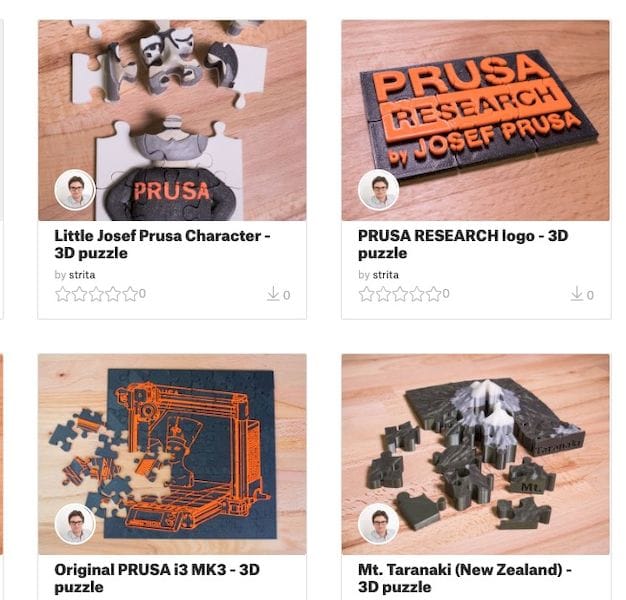![Some new 3D models uploaded to Prusa’s Model Marketplace [Source: PrusaPrinters]](https://fabbaloo.com/wp-content/uploads/2020/05/image-asset_img_5eb0987f25ade.jpg)
I’m thinking a lot about Prusa’s new 3D model repository, and wondering what it might mean.
As we reported the other day, Prusa announced a series of new online services, including a rather comprehensive platform for their growing online community, and a 3D model repository. Today it’s that repository that’s bothering me.
No, don’t get me wrong: the new Model Marketplace from Prusa seems to be a well-designed repository, functionally equal to or better than any other printable 3D model repository today.
The idea of a printable 3D model of repository started some years ago when desktop 3D printers were first introduced. At the time MakerBot took the initiative to create Thingiverse, their version of a repository.
Why did they develop Thingiverse when there were several and well-known 3D model repositories already on the web? The reason was two-fold.
First, virtually all of the repositories of the time were filled with non-printable models. The primary purpose for these repositories was to provide visual 3D assets for use in renderings, games or films. As a result, nearly all of the items you could download from these repositories were certainly not 3D printable.
That would be a big problem for a company looking to sell desktop 3D printers to consumers. MakerBot knew very well that the vast majority of the public are incapable of and not interested in learning how to 3D design their own objects. Thus, they would need a source of reliable content to use with their 3D printers. Hence, Thingiverse.
It also served as a key element of MakerBot’s ecosystem, in which those seeking models would be drawn towards MakerBot.
As it was the first of the major printable 3D model repository online, Thingiverse attracted a great deal of interest and of course, uploads of 3D models from participants. Over the years the number of models on Thingiverese has grown significantly, now believed to be over 3 million models.
Along the way several competitors realized the same strategy and established their own 3D model repositories. YouMagine (Ultimaker) and Pinshape (Formlabs) are two notable examples of this acquired strategy. Third-party repositories also appeared, with the most successful probably being MyMiniFactory, but most of the others struggled. We even attempted to start one of our own at one point! This is because they did not have a well-funded manufacturer backing them, as did Thingiverse, YouMagine and Pinshape.
It’s my understanding that none of these repositories have approached the size of Thingiverse’s massive repository. It seems that many people still, by default, will upload their creations to Thingiverse first.
This is in spite of a number of controversies surrounding Thingiverse over the years. Years ago, for example, the Thingiverse community was generally appalled when it appeared that MakerBot’s then-new owner, Stratasys, seemed to issue a patent for designs that had been contributed by generous users to Thingiverse. Since then there have been several incidents of copying and DMCA takedowns that have similarly riled the user base.
This anger is of such significance that one of our most popular posts all-time is “Alternatives To Thingiverse”.
But now we have a new player in the game: Prusa.
At first glance, Prusa’s repository is incredibly small compared to Thingiverse or the other mature repositories. Many times in the past I’ve seen hopeful new repositories emerge with a handful of 3D models, and I always feared for their survival as they simply didn’t have the traction to attract a significant amount of models. In almost every case, these repositories have since disappeared from the Earth.
But now the new player, Prusa, has an advantage none of these previous entrants had when facing Thingiverse: an enormous community that is growing rapidly.
Many who purchase one of the thousands of devices produced by Prusa each month will no doubt become a participant in the new Model Marketplace. On sales of the units alone, it’s a very clear that Prusa will generate more new users than MakerBot at this point.
Functionally, the Model Marketplace seems to have some slightly more advanced features than Thingiverse. This is unsurprising, as Thingiverse has been more or less static for quite a few years now. That’s likely due to MakerBot’s shift from the consumer/DIY market to education and professional markets, where there is far less emphasis on a public repository.
Thus, while Thingiverse has a seemingly staggering lead, there now appears to be a competitor that could actually catch them, eventually.











No one seems to offer collaborative 3D printing modes on dual extrusion devices. We explain why this is the case.